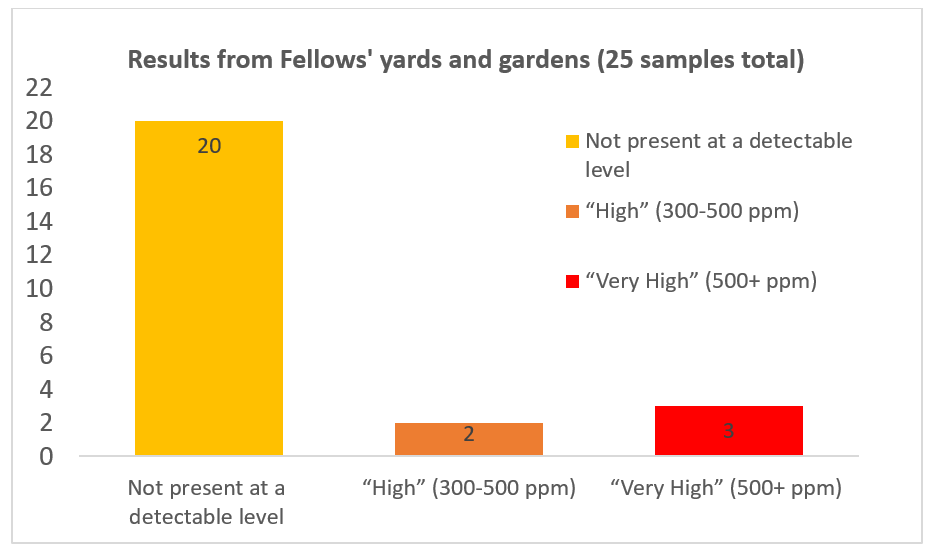In Summer 2021, a total of 18 residents learned how to test soil for lead and arsenic as NATURE Lab’s first group of Soil Justice Fellows. Of the 18 Fellows, 7 were youth in the Uptown Summer Program at The Sanctuary for Independent Media in July, and 11 were adults organized through the Our Soil Project in August.
Read here about why lead and arsenic may be found in Troy soils.
Testing Methods
What do soil samples represent?
The results of the soil tests are representative of the particular spot sampled at the time that the sample was taken.
The results do not tell us about the past and what exposure may have occurred. The results also do not tell us about the future of that particular location (we can improve the quality of soils).
The test results for a particular spot or yard do not tell us about the soil next door, or even the soil a few feet away. Lead and arsenic in soils can vary over short distances and is not the same everywhere. There are some general principles about where contaminants may be found, but testing soil is necessary to really know about a particular spot.
Although this variation across space makes it a challenge to identify where lead and arsenic are, it can also be a relief to find places that are OK.
How did we analyze the samples?
The two soil tests for lead and arsenic that the Fellows used are color-based tests that can be performed outside of a laboratory. Based on the color observed in each test, the bioaccessible amounts of lead and arsenic in the soil can be estimated:
- For the lead test, soils can be ranked as containing low (0-150 ppm), medium (150-300 ppm), high (300-500 ppm), and very high (500+ ppm) amounts of lead.
- For the arsenic test, soils can be ranked as containing low (0-10 ppm), medium (10-50 ppm), high (50-300 ppm), and very high (300+ ppm) amounts of arsenic.
With both tests, color rankings of “medium” and higher are likely indicators that industrial contributions of lead and arsenic are present in the soil. You can read more about these two color-based soil tests here.
Results
Approximate amounts of lead and arsenic were measured with the color-based tests. In many samples, the amounts of lead and arsenic were less than the tests could detect. This finding means that there may be lead and arsenic, but it was below the detection limit of the color-based test. In other samples, “Medium,” “High,” and “Very High” amounts were found. This finding is less reassuring, but not unexpected, and now we know locations where action can be taken to protect public health. Details of these tests follow.
Fellows collected 12 samples from locations where children and youth play. Lead and arsenic were not present at detectable levels in any samples taken from these locations:
- 4 samples at Troy Central Little League Field (tested only for lead)
- 5 samples at the playground in 112th Street Park
- 2 samples at the playground at Canal Avenue & 3rd
- 1 sample at the playground in Prospect Park
Fellows also collected 5 samples from Collard City Garden, located near the Sanctuary for Independent Media. Lead was not present at a detectable level in these samples. Arsenic tests were not conducted.
Fellows collected 25 samples from their own yards and gardens, with the following results:
Lead
- Lead was detected in 5 samples from 5 yards and gardens.
- 2 samples had “High” (300-500 ppm) lead concentrations
- 3 samples had “Very High” (500+ ppm) lead concentrations
- Lead was not present at a detectable level in the other 20 samples.
 Arsenic
Arsenic
- Arsenic was detected in 1 sample from 1 garden. In this sample, the test indicated a “Medium” arsenic concentration.
- Arsenic was not present at a detectable level in the other 24 samples.
What we can do with these results
- Where contamination was found, Fellows took actions such as covering bare soils and relocating garden areas.
- We recommend that everyone in Troy who is concerned about lead and arsenic exposure cover any bare patches of soil around their homes.
- The City of Troy provides free mulch, which is a great resource for covering soil in yards and gardens.
- Planting grass or other ground-covering vegetation is another good option.
- For gardeners, it is a good idea to created raised bed gardens, introducing new soil rather than disturbing potentially contaminated soil.
The links below provide more information and guidance on steps you can take.
- Read here about how people in Troy could be exposed to contaminated soils, and how to prevent exposures.
- Find local resources related to housing, food, gardening, soil testing, and more.